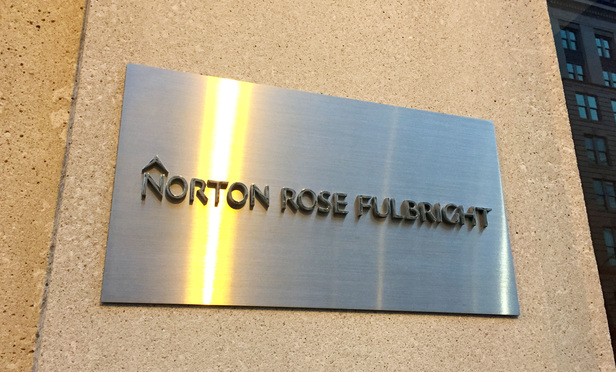 Norton Rose Fulbright’s offices in Washington, D.C. February 20, 2016.
Norton Rose Fulbright’s offices in Washington, D.C. February 20, 2016.
(Photo: Diego M. Radzinschi)
So, after roughly a year of negotiations, the deal between Norton Rose Fulbright and New York-based Chadbourne & Parke is finally complete.
Thanks to its latest combination, serial acquirer Norton Rose now has around 4,000 attorneys, a quarter of which are in the United States, as well as a network of 58 offices in 32 countries, and annual revenues of about $2 billion. Big Law indeed.
If large-scale law firm mergers are widely accepted to be extraordinarily difficult things to pull off, somebody clearly hasn’t told Norton Rose. By my count—and I’ve almost certainly missed some—this is the firm’s eighth full-blown merger or acquisition in the past seven years. The legacy Norton Rose’s revenue has increased by approximately 400 percent over that time, while its lawyer head count has quadrupled. Growth doesn’t necessarily mean anything in and of itself, of course, but that’s still pretty remarkable.
The respective management teams will no doubt this evening be toasting a job well done—particularly given the fact that the last five months of discussions and planning were carried out under some pretty intense media scrutiny, thanks to the news breaking way back in February, which always makes things more difficult. (As an aside, it’s interesting that Fulbright & Jaworski’s name became part of the Norton Rose brand following its combination in 2013, whereas the Chadbourne moniker will now be consigned to the history books. That may seem like a trivial matter, but a firm’s post-merger name is often an emotive issue for partnerships. In fairness, Fulbright was more than double the size of Chadbourne, by both revenue and number of lawyers. But for a firm with a proud 115-year history, it still won’t have been an easy pill to swallow.)
But as hard as it is to actually get these deals over the line—and approved by partnerships that are generally risk- and change-averse—the most challenging part is still to come: integration.
The way that a law firm manages the post-merger integration process is the key to whether the deal succeeds or fails. It is also the most difficult thing to get right. This is particularly true of transatlantic mergers, where firms face the complex and potentially costly issue of reconciling contrasting approaches to everything from tax and accounting to conflicts and partner compensation. It is perhaps unsurprising, then, that the track record of previous transatlantic law firm mergers has been mixed at best. Hogan Lovells is arguably the high-water mark, as I examined in a recent feature article with Legal Week’s Rose Walker. DLA Piper, on the other hand, spent the better part of a decade grappling with integration issues. Clifford Chance and Rogers & Wells? The less said about that, the better.
The fact that Norton Rose is structured as a Swiss verein—a holding structure that allows member firms to join forces yet retain their existing forms—means that it is able to sidestep or at least mitigate many of these hurdles. Almost every major cross-border law firm combination of the past decade has been carried out via a verein, including those that formed Dentons, DLA Piper, Hogan Lovells, King & Wood Mallesons and Squire Patton Boggs. (A number of more recent deals, such as Eversheds Sutherland, have instead opted for an alternative structure that is favored by the Big Four accounting firms, however.)
This also isn’t the firm’s first rodeo (see below for a full list of combinations). Those at the helm—on the Norton Rose side, at least—have perhaps more experience in carrying out these deals than anyone else currently working in Big Law.
But there is a flip side to that coin. Management now has to integrate yet another firm into an organization that has bolted on more parts than a street racer’s Honda Civic, while still retaining some semblance of a cohesive culture and attempting to bend as few noses out of joint as possible. That requires an extraordinary blend of business sense and diplomacy, and doesn’t get any easier, no matter how many times you’ve done it.
The Many Deals of Norton Rose Fulbright
2010: Deacons (Australia)
2011: Ogilvy Renault (Canada); Deneys Reitz (South Africa)
2012: Macleod Dixon (Canada)
2013: Fulbright & Jaworski (United States)
January 2017: Bull, Housser & Tupper (Canada)
June 2017: Henry Davis York (Australia)
June 2017: Chadbourne & Parke (United States)
Chris Johnson is based in London, where he writes about global law firms and the business of law.




